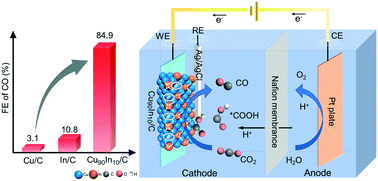Metal–organic framework derived carbon supported Cu–In nanoparticles for highly selective CO2 electroreduction to CO†
Abstract
Cu-based materials are promising electrocatalysts for the CO2 reduction reaction (CO2RR). However, they still suffer from intense hydrogen evolution, as well as low selectivity and efficiency for the CO2RR. In this work, Cu–In bimetallic catalysts for the CO2RR were prepared by the pyrolysis of Cu–In metal–organic framework (MOF) materials. Cu90In10/C with a Cu/In molar ratio of 9/1 exhibited a high CO selectivity of up to 85% at −0.75 V versus the reversible hydrogen electrode, compared with 3.1% on Cu/C and 10.8% on In/C. On the Cu90In10/C catalyst, In was found to be locally distributed on the surface of Cu nanoparticles, forming Cu4In, changing the geometric and electronic structures of the Cu surface. These modifications were supposed to have modulated the adsorption properties of the catalyst for *H, CO2 and the intermediates during the CO2RR, therefore the electrochemical conversion of CO2 to CO was enhanced and hydrogen evolution was mitigated. The enlarged electrochemically active surface area and the accelerated charge transfer and reaction kinetics of this Cu–In bimetallic catalyst also contributed much to its excellent CO2RR performance. This work not only highlights the superior CO2 electroreduction performance of bimetals over monometals, but also provides a new method to develop bimetallic catalysts.



 Please wait while we load your content...
Please wait while we load your content...